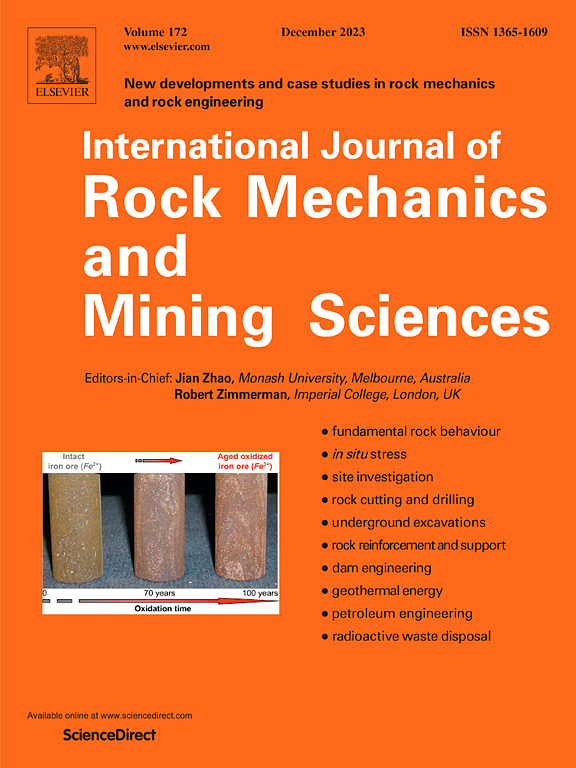Effect of hydro-chemical corrosion on mechanical properties of red sandstone under uniaxial and triaxial compression
IF 7
1区 工程技术
Q1 ENGINEERING, GEOLOGICAL
International Journal of Rock Mechanics and Mining Sciences
Pub Date : 2024-11-24
DOI:10.1016/j.ijrmms.2024.105967
引用次数: 0
Abstract
The degradation of mechanical characteristics of sandstone, a common engineering material in acid environment, is directly related to the project service life forecast. In order to investigate the influence of water–rock interaction on the mechanical properties of red sandstone, a series of uniaxial and triaxial compression tests were conducted on sandstone immersed in solutions of different pH values and immersion times. Moreover, the effects of acid chemical corrosion on the microscopic structure of the sandstone were analyzed using scanning electron microscopy (SEM) and energy dispersive spectrometer (EDS) tests. A chemical damage strength model was then formulated within the theoretical framework of chemical reaction kinetics theory. The results indicate that the different hydro-chemical solutions have a significant deterioration effect on the sandstone. In immersion tests, the water–rock reaction of sandstone is essentially completed after 30 days of immersion. With increasing immersion time, the uniaxial compressive strength of sandstone immersed in neutral and weakly acidic saline solutions shows an initial rapid decrease followed by a slow increase, while sandstone immersed in distilled water and strongly acidic solutions shows varying degrees of decrease over time. High confining pressure weakens the corrosion effect of the solutions on the sandstone, particularly, the neutral solution. In the triaxial compression tests, strong acid has a great corrosion effect on sandstone. The average peak strength of sandstone immersed in pH2, pH4, pH7, and distilled water decreased by 30.2%, 28.7%, 25.1%, and 22.8%, respectively. The model considers calcium precipitation not only reflects the change in pH value of the immersion solution with time but also effectively predicts the strength of sandstone immersed in different solutions. The results deepen our understanding of the deterioration mechanism of silicon-based porous rock under different chemical solutions and would be of importance for the long-term stability analysis of rock engineering in complex groundwater environments.
水化学腐蚀对红砂岩单轴和三轴压缩力学性能的影响
砂岩是酸性环境中常见的工程材料,其力学特性的退化直接关系到工程使用寿命的预测。为了研究水-岩相互作用对红砂岩力学性能的影响,对浸泡在不同 pH 值和浸泡时间溶液中的砂岩进行了一系列单轴和三轴压缩试验。此外,还利用扫描电子显微镜(SEM)和能量色散光谱仪(EDS)测试分析了酸性化学腐蚀对砂岩微观结构的影响。然后在化学反应动力学理论框架内建立了化学损伤强度模型。结果表明,不同的水化学溶液对砂岩有显著的劣化作用。在浸泡试验中,砂岩的水岩反应在浸泡 30 天后基本完成。随着浸泡时间的增加,浸泡在中性和弱酸性盐溶液中的砂岩的单轴抗压强度最初会迅速下降,然后缓慢上升,而浸泡在蒸馏水和强酸性溶液中的砂岩随着时间的推移会出现不同程度的下降。高封闭压力削弱了溶液对砂岩的腐蚀作用,尤其是中性溶液。在三轴压缩试验中,强酸对砂岩的腐蚀作用很大。浸泡在 pH2、pH4、pH7 和蒸馏水中的砂岩的平均峰值强度分别降低了 30.2%、28.7%、25.1% 和 22.8%。考虑了钙沉淀的模型不仅反映了浸泡液的 pH 值随时间的变化,还有效地预测了浸泡在不同溶液中的砂岩的强度。这些结果加深了我们对硅基多孔岩石在不同化学溶液下劣化机理的理解,对复杂地下水环境下岩石工程的长期稳定性分析具有重要意义。
本文章由计算机程序翻译,如有差异,请以英文原文为准。
求助全文
约1分钟内获得全文
求助全文
来源期刊
CiteScore
14.00
自引率
5.60%
发文量
196
审稿时长
18 weeks
期刊介绍:
The International Journal of Rock Mechanics and Mining Sciences focuses on original research, new developments, site measurements, and case studies within the fields of rock mechanics and rock engineering. Serving as an international platform, it showcases high-quality papers addressing rock mechanics and the application of its principles and techniques in mining and civil engineering projects situated on or within rock masses. These projects encompass a wide range, including slopes, open-pit mines, quarries, shafts, tunnels, caverns, underground mines, metro systems, dams, hydro-electric stations, geothermal energy, petroleum engineering, and radioactive waste disposal. The journal welcomes submissions on various topics, with particular interest in theoretical advancements, analytical and numerical methods, rock testing, site investigation, and case studies.

 求助内容:
求助内容: 应助结果提醒方式:
应助结果提醒方式:


